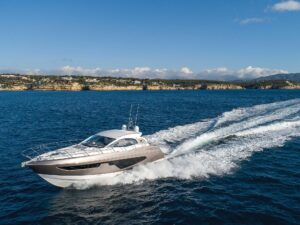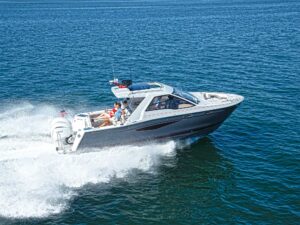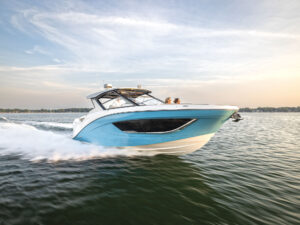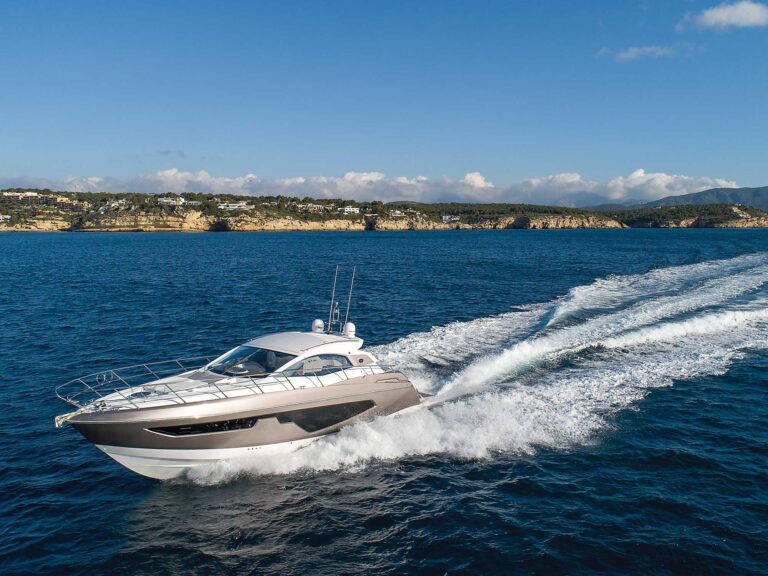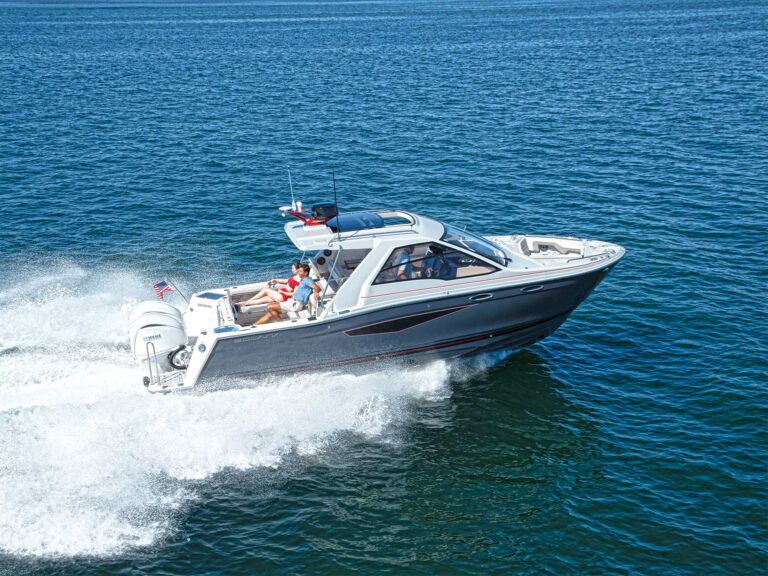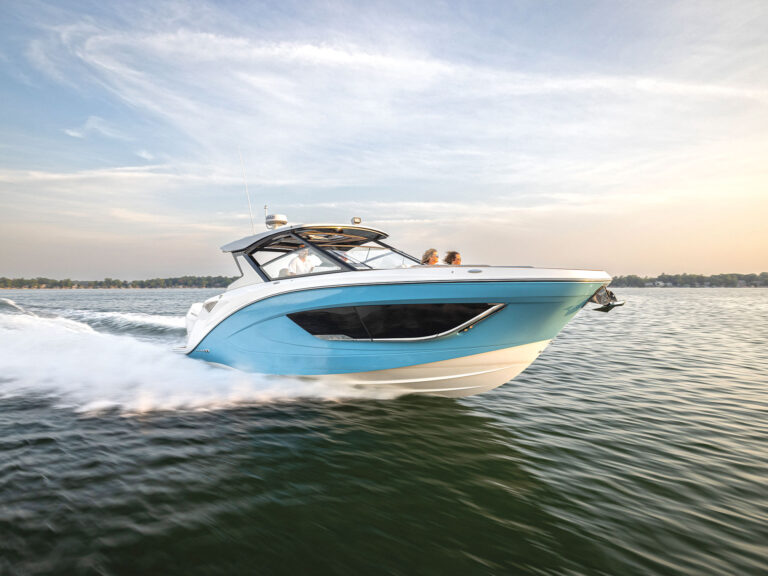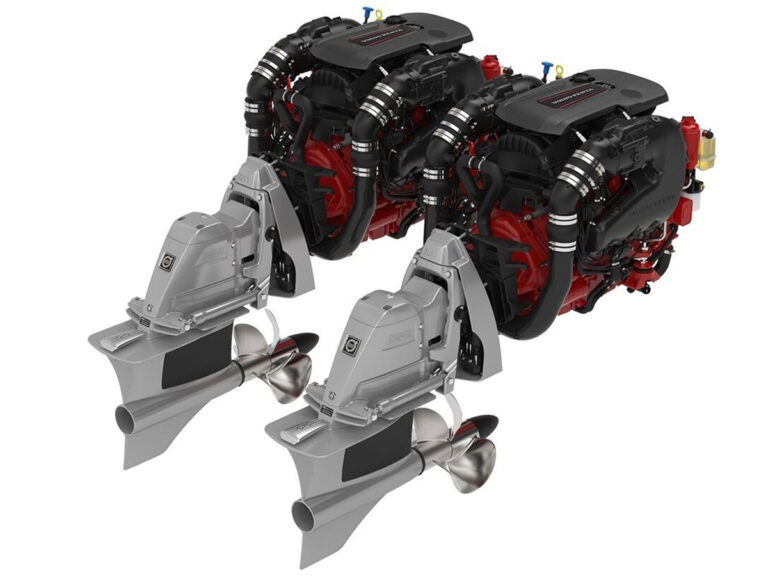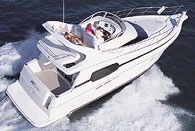
Silverton 410
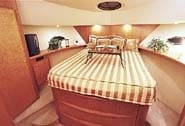
Silverton 410
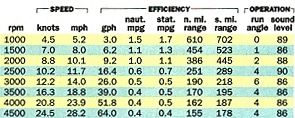
Silverton 410 Specs

Silverton 410
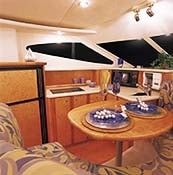
Silverton 410
It can be argued that a sedan – A flying bridge cruiser – such as the new Silverton 410 Sport Bridge, being there is more important than getting there. But click the 410 Sport Bridge’s trannies into gear, push its throttles forward, and you’ll agree that getting there can be more fun than you expected. With twin 405-hp Crusader 8.2-liter MPI gasoline inboards turning 23″-by-21″ propellers through deep, 2.68:1 Hurth 630A marine gears, our test boat got up and strutted to a respectable 28.2 mph with authority. Turning was responsive. And the 410 Sport Bridge stays on plane at only 15 mph, an often overlooked quality that allows you to keep control in rough seas.
All this confidence you feel at the helm is not surprising when you realize it’s the result of all those horses turning the boat’s nearly square, cupped propellers through low gears. This combination gets the 410 Sport Bridge up and going at a good pace, despite the fact that it weighs 7,500 pounds more than Bayliner’s 3988 Command Bridge ($274,995 with twin 315-bhp Cummins diesels), 7,000 pounds more than Sea Ray’s 400 Sedan Bridge ($408,000 with twin 380-hp MerCruiser inboards), and 6,000 pounds more than Jefferson’s 43 International ($329,900 also with twin 380-hp MerCruiser inboards).
At $304,427 as tested and with options (add $38,595 for a pair of 315-bhp Cummins diesels), the 410 Sport Bridge isn’t the least expensive boat in this group, but it has a wonderful accommodation plan, rugged construction, and don’t forget how well it performs while underway.
LOOKIN’ GOOD. COOKIN’ GOOD. The 410 Sport Bridge’s distinct, Euro-wedge styling is more than cosmetic. The gunwales sit lower on the more traditionally styled 400 Sedan Bridge, 3988 Command Bridge, and 43 International than on the 410 Sport Bridge. Starting just above the cockpit, the sidedecks on these competitors run forward, eating up valuable interior space.
THE HIGHS: Galley with a true view. Superior interior joinerwork. From engine installation to towel bars, it’s well built. The “sidewalk” sidedecks are great.** **
THE LOWS: Helm needs nonglare treatment. Cockpit lacks some steps and a latch to secure the boarding door open. Opt for the stainless-steel windshield upgrade.
Why did Silverton’s designers raise the 410 Sport Bridge’s gunwales? To get better use of the boat’s 14’8″ beam for the interior. So, where are the sidedecks? They begin atop the flying bridge. Simply walk up the steps – not a ladder – to the bridge. From this roomy entertaining area, it’s an easy walk down a gentle incline to the bow. Not only does the 410 Sport Bridge have more beam than its competitors, it has a greater proportion of its beam dedicated to its interior space and provides safe bow access in the process.
And how they used this space is, well, breathtaking. Instead of locating a galley that’s “down” several steps below the salon, as aboard the 43 International, or “up” on the salon level, as aboard the 3988 Command Bridge and 400 Sedan Bridge, the 410 Sport Bridge’s cooking-and-dining area is placed two steps above the salon level. It’s a galley-up-up. Tucked under and against the windshield, this galley offers the cook and crew a 180-degree panorama.
Consider this for a moment: No longer will you and your crew feel trapped inside at mealtime, suffering from de-sight-dration, getting all grumpy and listless. No more fights for the one seat that faces the companionway. No more vistas filled with barnacle-encrusted pilings or your neighbor’s topsides while in the slip.
Yeah, I know. You could serve the catch of the day in the cockpit or on the flying bridge. But then you’d have to wrestle with folding tables, dodge mosquitoes, and make the inevitable three trips to the galley for an extra lemon wedge, the salad tongs, and those stupid corn holder things. On the other hand, inside the 410 Sport Bridge you can dine in bug-free, humidity-controlled comfort with a gull’s-eye view of the water in which you dropped your hook. Also, it’s a great place to keep an eye on the kids as they play with the dink in your anchorage.
SUPERIOR ATTITUDE. The finish inside the 410 Sport Bridge is decidedly upscale. The stainless-steel sink is installed with its flange below the two-tiered Corian counter. Cabinetry and paneling throughout is bookmatched, straight-grained cherrywood with burled accents. Tightly butted joints are proof of solid carpentry and provide a modern, seamless look.
Step down into the salon and you’re met by a burled counter and two bar stools. A breakfast nook? Yes. But the 110-volt AC outlet and phone jack also make this the spot to boot up and check your e-mail or get the latest weather information online. Pick up the remote and switch on the Bose Lifestyle 30 Sound System ($4,995). Its amazingly small speakers provide colossal audio while your crew mills about on the 410 Sport Bridge’s lush, padded carpet or lounges in the convertible, Ultraleather settees. Registers for the dual-zone a/c system ($11,530) are hidden inside the headliner’s sculpted valances. No brown-painted grates here. Finely fitted hatches in the salon sole cover the engine room. Pull up a hatch and take a gander at those hefty steel beams that span the bulkheads. Bolted onto beds like these, the 410 Sport Bridge’s engines are as secure as those of an inlet-busting, offshore fishboat. They’ll stay put, and aligned, for the long haul.
Now descend the curved stairs and go belowdecks. Solid, raised-panel doors conceal master and guest staterooms that feature full-size innerspring mattresses and more bookmatched cherrywood. The split head arrangement – the shower is to port and the commode with sink and vanity is to starboard – is convenient when it’s time to read and someone needs to shower. The split head can be accessed from the passageway or from each stateroom. Grab the towel rack. Lean back. It easily bears your weight as does every other fixture aboard the 410 Sport Bridge.
THIS WAY UP. Access to the 410 Sport Bridge’s flying bridge, as aboard the 400 Sedan Bridge, is up a set of wide, molded steps with a handrail, rather than a ladder such as the one aboard the 3988 Command Bridge. Up here you can walk out to the bow on wide “sidewalk” sidedecks. No longer will you whack your shoulders or be forced to shuffle sideways to walk to the bow or the sunlounge. Going forward is safe and easy. The helm is wide and white – too white in my opinion. Some gray or black panels would reduce the glare. A Plexiglas Venturi windshield is standard, but take my advice and opt for the stainless-steel framed fiberglass unit ($2,999). Not only does it double as a grabrail, but it complements the design of the 410 Sport Bridge better. The arch is aluminum instead of fiberglass. Yes, it costs more, but it doesn’t sway underway. There’s plenty of seating, a wetbar, and a second sunlounge up here, too.
The cockpit? It’s deep and self-bailing, plus there’s ample room to party. Shoreside utility connections are within easy reach. Our test boat lacked cockpit steps, but Silverton says they’ll be added to production models. Check that they are; otherwise, it will be a long step up to the gunwale without them. And unless you are berthed at a floating dock, the swim platform won’t help you gain the shore. Also, a latch to secure the boarding door in the open position would be a welcome addition.
LAST WORD. Not only is the Silverton 410 Sport Bridge a well-built, capable performer, but its galley design sets a new standard.
LOA……….45’9″
Beam……….14’8″ ** **
Draft……….3’3″ ** **
Displacement (lbs., approx) ……….29,000 ** **
Transom deadrise…..16° ****
Bridge clearance…..16’0″ ****
Minimum cockpit depth ……….2’10” ****
Max. cabin headroom…6’8″ ****
Fuel capacity (gal.)…..450 ****
Water capacity (gal.)…210 ****
Price (w/standard power) ……….$249,860 ****
Price (w/test power) ……….$249,860 ****
STANDARD POWER: Twin 405-hp Crusader 8.2L MPI V-8 gasoline inboards.****
OPTIONAL POWER: Twin gasoline inboards to 810 hp total; twin diesel inboards to 860 bhp total. ****
TEST BOAT POWER: Twin 405-hp Crusader 8.2L MPI V-8 gasoline inboards with 502 cid, 4.47″ bore x 4.00″ stroke, swinging 23″ x 21″ four-bladed Nibral props through 2.68:1 reductions.
STANDARD EQUIPMENT (major items): Flying bridge AM/FM/ CD stereo; 2 sunpads; transom shower; wetbar; AM/ FM/CD stereo w/6 speakers in cabin; convertible settee; designer blinds; innerspring mattresses; enclosed separate stall shower; electric head; parallel start switch; compass; life vests; bottom paint; anchor; trim tabs; Manganese bronze struts and rudders; coffeemaker; electric range; microwave; refrigerator/freezer.

